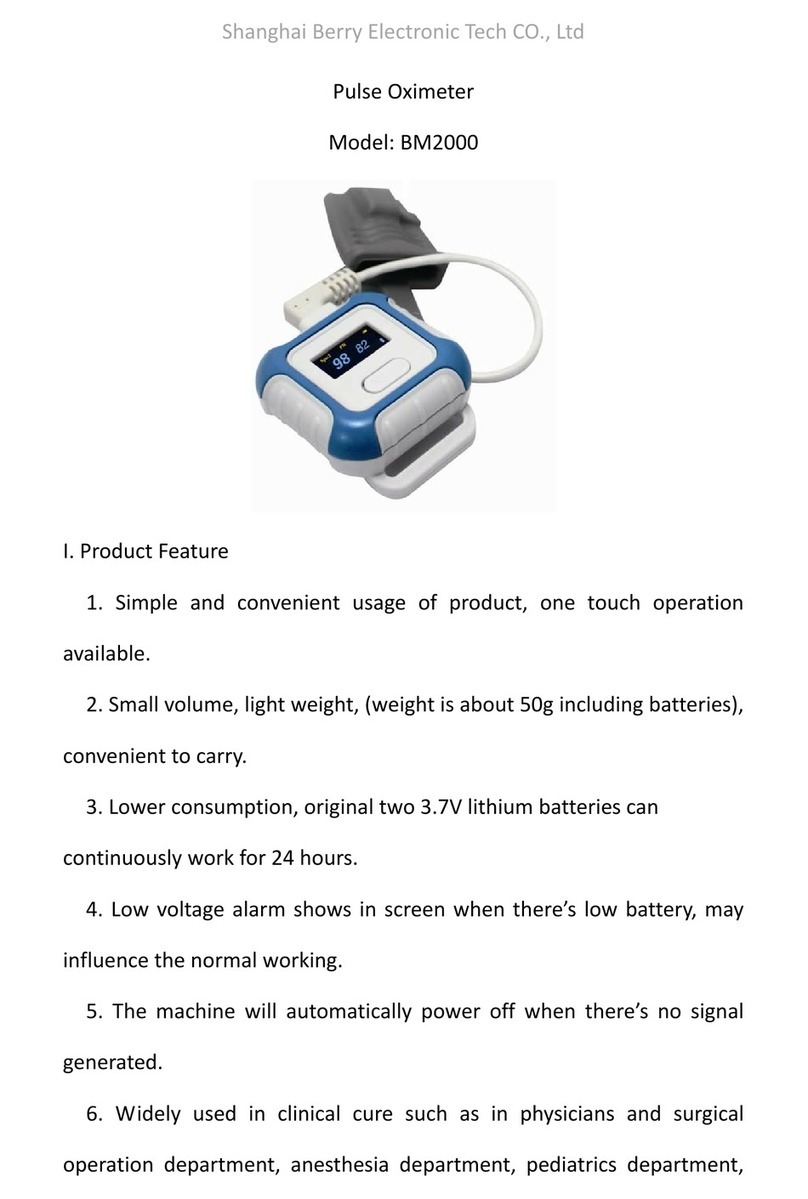anesthetics, explosive substances, vapors or liquids.
⚫Make sure not to use the pulse oximeter during MRI (magnetic resonance imaging)
scanning or CT (Computed Tomography)environment because induced current could
potentially cause burns.
⚫The pulse oximeter is without alarm function. Continuous monitoring for a long time is
not suitable.
⚫No modification of this product is allowed. Maintenance should be operated by
professional maintenance personnel who are approved by manufacturers.
⚫Please shut off the power before clean the pulse oximeter. Never permit high-pressure
and high-temperature disinfection of the device. Never use cleaning agents/disinfectants
other than the recommended.
⚫The product is commonly seal product. Keep its surface dry and clean, and prevent any
liquid from infiltrating it.
⚫The pulse oximeter is precision and fragile. Avoid pressure, knock, strong vibration or
other mechanical damage. Hold it carefully and lightly. If it is not in use, it should be
appropriately placed.
⚫For disposal of pulse oximeter and accessories, follow local regulations or your
hospital’s policy regarding disposal of such pulse oximeter and accessories. Do not
dispose randomly.
⚫Use AAA alkaline batteries. Do not use carbon or poor quality batteries. Remove the
batteries if the product is not to be used for a long time.
⚫A functional tester can’t be used to assess the accuracy.
⚫If patient is an intended operator, you must read the operation manual carefully and
understand deeply or consult with the doctor and manufacturer before using. If you
have any discomfort in use, please stop using immediately and go to the hospital.
⚫Avoid static electricity, before using the pulse oximeter, confirmed direct or indirect
static electricity of all the operators and patients who contact with the instrument.
⚫When in use, try to make the pulse oximeter keep away from radio receiver.
⚫If the pulse oximeter uses unspecified and without EMC test system configuration, it
can enhance electromagnetic radiation or reduce anti-electromagnetic interference
performance. Please use the specified configuration.
⚫Portable and mobile radio frequency communication equipment can affect the normal
use of the pulse oximeter.
⚫The pulse oximeter should not be close to or stacked with other equipments, if you must
be close to or stacked them in use, you should observed and verify that it can run
normally with the configuration which it uses.
⚫It should ensure that there is no dirt or wound on the tested part.
⚫Federal law restricts this device to sale by or on the order of a physician.
⚫If the product is intended to allow direct diagnosis or monitoring of vital physiological
processes, then it is likely to result in the immediate danger to the patient.
⚫Please keep this oximeter and its accessories in a safe place to prevent pet bites from
breaking or pests from entering. Keep oximeters and small parts such as batteries out of
the reach of children to avoid accidents.
⚫Mental retarded persons must be used under the guardianship of normal adults to































